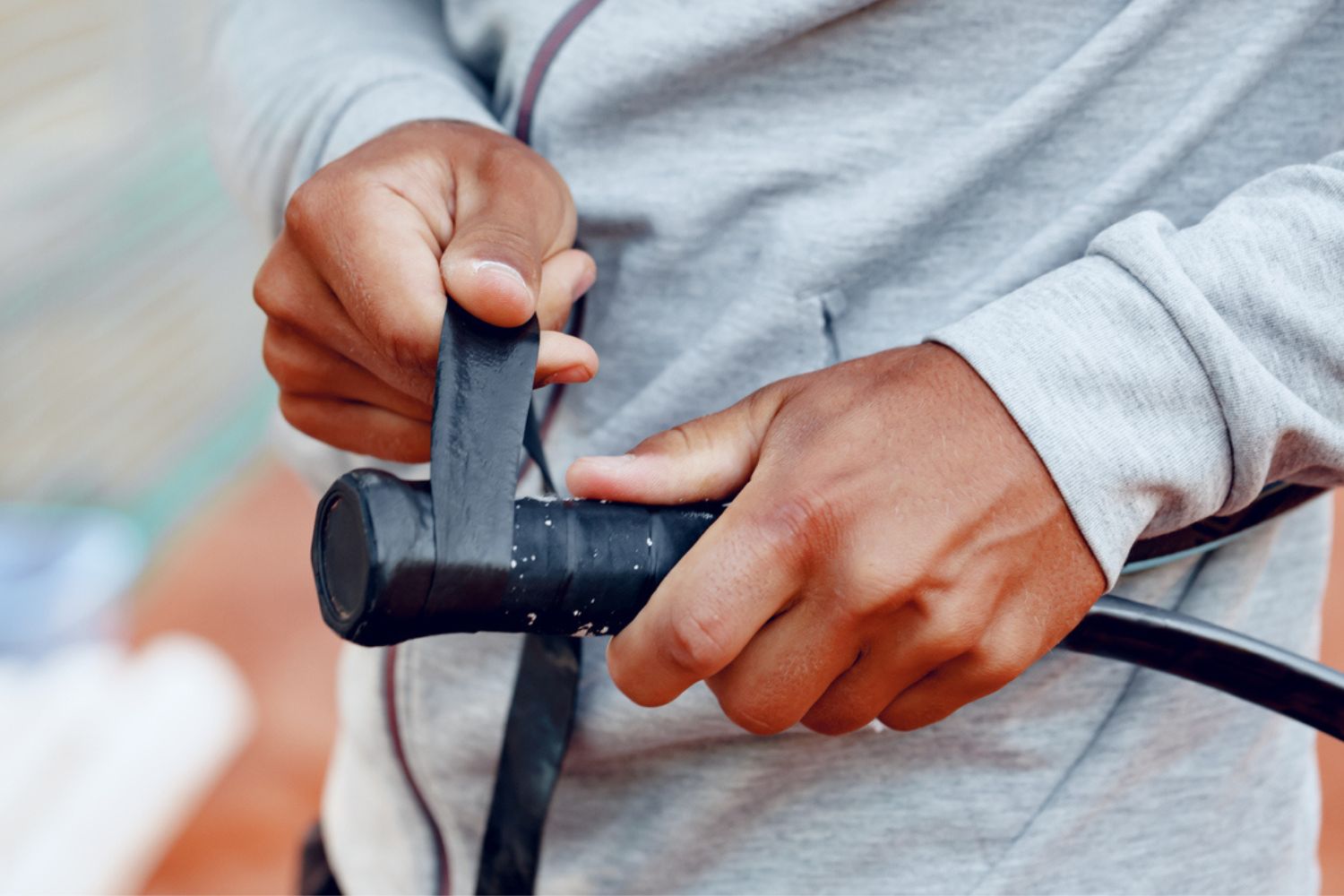A fresh gripped tennis racket is one of the most satisfying things on the court. Nothing beats the softness and the secure feeling of a brand new grip, which helps the players to perform better and boosts their confidence. However, not everyone knows how to regrip a tennis racket, especially when starting out and are still in the beginner phase.
If you are one of those people, I am glad to say that you just landed on the right site. Thanks to my experience as a USPTA certificated tennis trainer; I will teach you exactly how to do it, so you’ll be able to keep your equipment in great shape for a longer time. It’s normal for rackets to wear out and become slippery over time, so if you are serious about tennis, it’s important to learn this stuff.
Regripping Tools Checklist
- Tennis racket
- New grip
- Tennis rubber band (optional)
- Scissors or a small knife
- Finishing tape
- Detergent
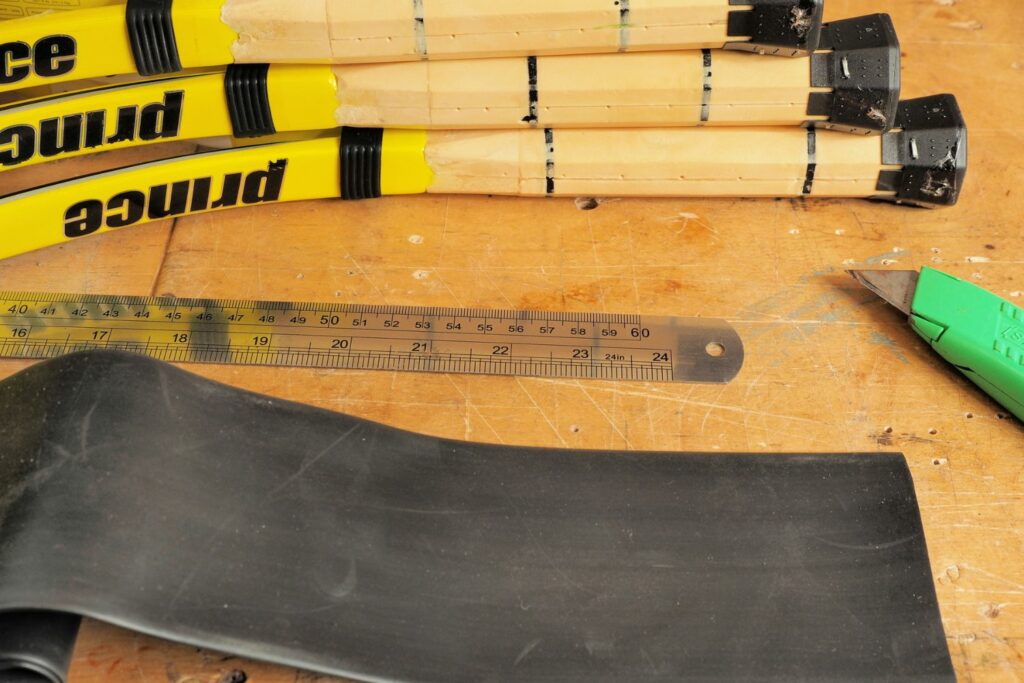
How to Regrip a Tennis Racket
You’ll know it’s time to grip your tennis racket when the old grip has become too old, torn apart, slippery, dirty, has lost the tackiness and softness, or all of these things together. Adding an overgrip is also a great and smart way to add more thickness to the racket’s handle size when you feel like the tennis racket grip is too thin or it’s hard to control because it twists in your hand.
This is a basic skill for all tennis players out there because as your skills grow, you’ll need a regrip more often. Fortunately for you, it’s not a complicated process at all, and with just a little bit of practice, you can master it in no time. Follow these steps to learn how to regrip a tennis racket correctly.
Step 1: Remove your old overgrip.
First and foremost, make sure to slide off the vibration dampener of your racket, if you have it on, because it keeps the grip in its place, preventing the grip from unwrapping. Then, peel the grip off by using your own nails, a pair of scissors, or a small knife so that it will unwrap entirely.
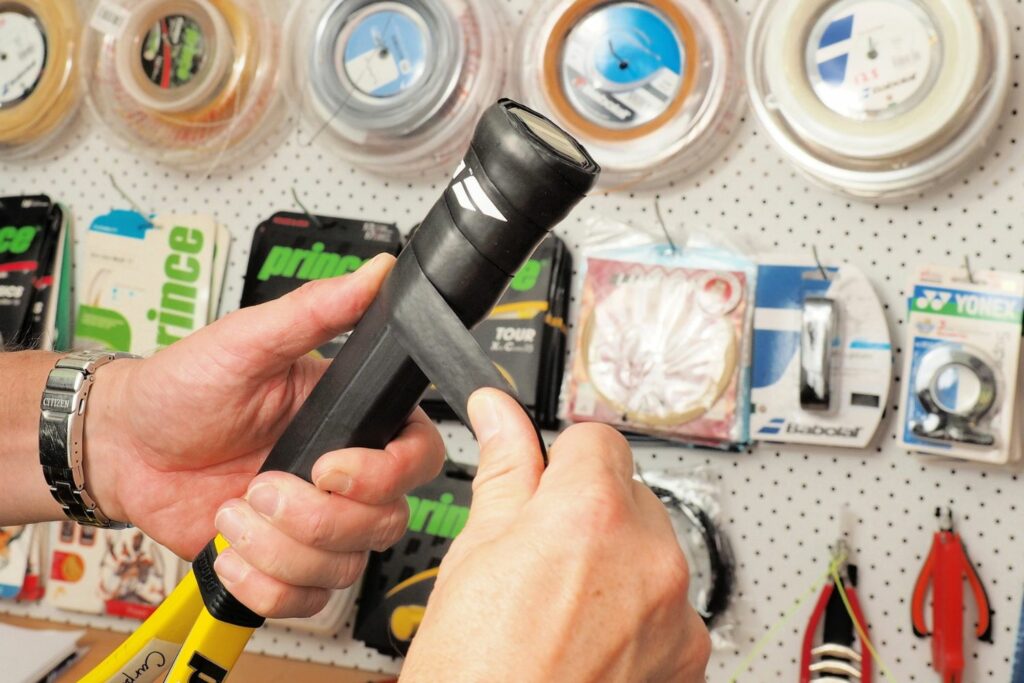
Step 2: Find the tapered side.
Get off the new grip from the factory plastic packaging, and spread it out. Usually, there should be a tapered side on one end of the overgrip that has a small and sticky banding depending on the brand. Find that, and make sure you remove the backing before moving on to the next step.
Step 3: Follow the handle.
To tell in which direction you should overgrip the handle, take a look at the bevels. They all have diagonal etchings that help the players know which direction to follow. However, your game style is critical in this step because you want to wrap the handle in a way that suits you best.
To slightly increase the handle’s width, make sure to avoid pulling the grip tightly or wrapping it around several times. If you want a tight wrap, then the grip should be as thin as possible. Make sure you take full advantage of whatever you choose based on your skill set and game style.
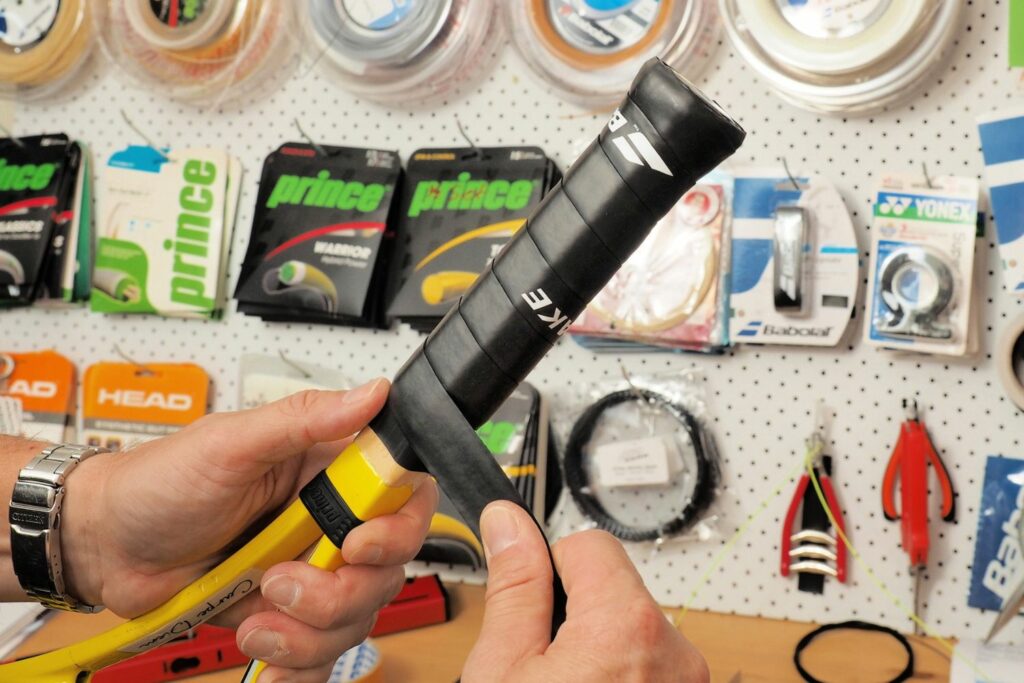
Step 4: Start at the but.
To regrip a tennis racket, start wrapping from the bottom side up while making sure that the overgrip’s tapered side is slightly angled up towards one of the shorter bevels. You should not lay the overgrip over the racket’s butt cup, so remember to avoid this, or else you’ll ruin the process.
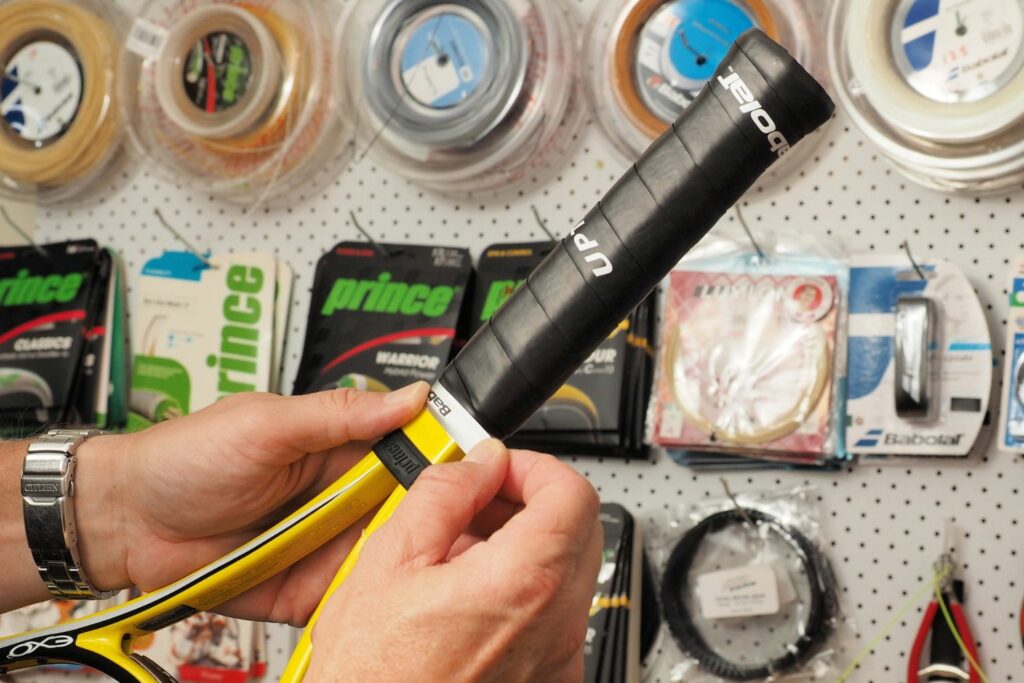
Step 5: Secure the tape.
The wrapping of the new overgrip should be comfortable and make your grip feel secure. Get rid of any excess material when you get on the top of the handle by cutting it with scissors or a knife. With a finishing piece, the tape sticks the grip around the handle so it stays in place. Lastly, pull back down the vibrational dampeners, at the top of the handle, as usual.
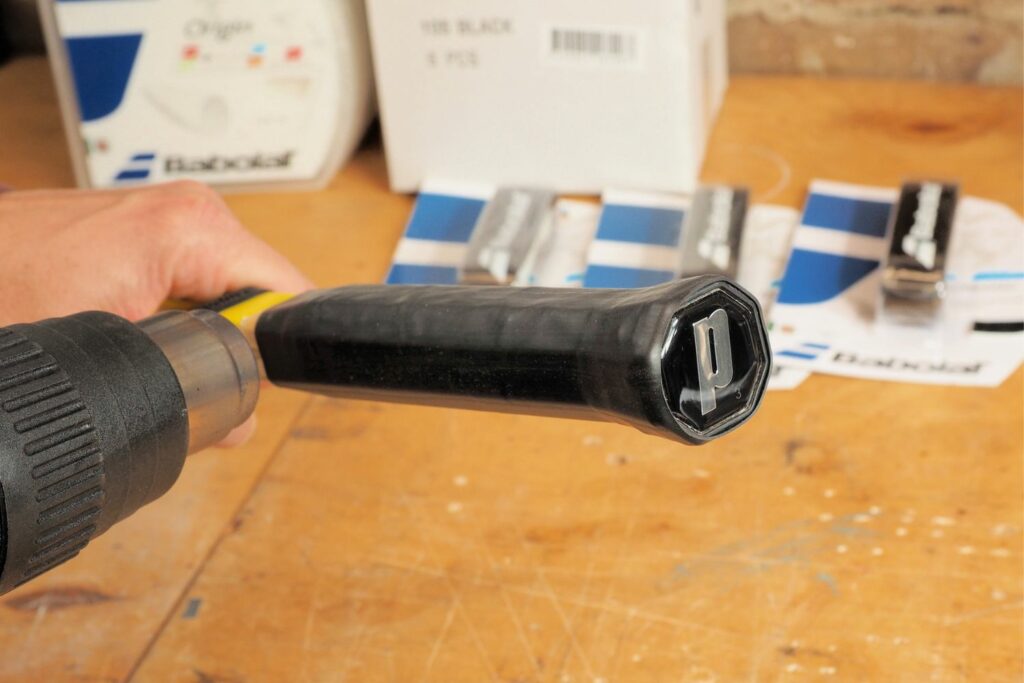
How to Replace a Tennis Racket Grip
Sometimes, regripping is not enough, and you might need a brand new tennis racket grip. Usually, the stock grips are made of leather and synthetic materials and are much thicker and more durable than the standard-sized ones. The replacement process is slightly different, so here is a step-by-step guide on how to replace a tennis racket grip.
Step 1: Remove your old overgrip.
Start by peeling off the old grip or overgrip from the top of the handle, all the way to the bottom. You’ll notice that the handle will have adhesive left from the default overgrip. Make sure to get rid of it by cleaning the handle with a specialized product or dishwasher soap. The handle should not be sticky but clean and dry instead.
Step 2: Remove the staple.
Now it’s time to prepare the new grip. The first thing you should do is remove the staple, which is a small piece of plastic from the grip’s factory packaging. Find the side where it is, usually at the bottom, and release it by hand or with a small sharp tool like scissors, a small knife, a narrow screwdriver, or needle-nose pliers.
Step 3: Slide in the dampener
Some players prefer to use rubber dampeners because they find it useful to reduce vibration and shock when the stringbed comes in contact with the ball. Their main function, however, is to mute the ping sound of the racket.
Whether you use a vibration dampener or not is completely up to you, but in case you do, make sure to slide it right after you have finished removing the old grip and cleaning the handle. If you wait until you have finished regripping a tennis racket, it might be harder to slide it on.
Step 4: Secure your racket.
Before starting regripping the racket, you have to ensure it’s secure and won’t move during the process, or else it will ruin all your hard work. This is a simple but important step, so make sure it will stay in place by turning it upside down and fixing the racket’s head in between your legs while keeping the handle firmly.
Step 5: Start wrapping.
It’s time to start wrapping finally, so line up the tapered end of the new grip at the same level as the old one. The motion’s direction is actually very important, depending on your dominant hand.
If your right hand is the dominant one, you should wrap it to your right; the rest of the material will follow your starting point. Do the contrary if you are left-handed; by pulling the tape to the left and wrapping it in that direction. By using your dominant hand, you’ll do a better job and be more comfortable.
Step 6: Wrap up the handle.
Wrap the new grip from the bottom up, making sure that the tape is slightly angled upwards a small bevel, covering about one-sixteenth of an inch every time you wrap the handle around.
The grip should lay flat on the handle, so it won’t wrinkle or go loose. When you have finished a full grip and reached the handle’s top, repeat the same process repeatedly by wrapping the grip over the top until you are finished.
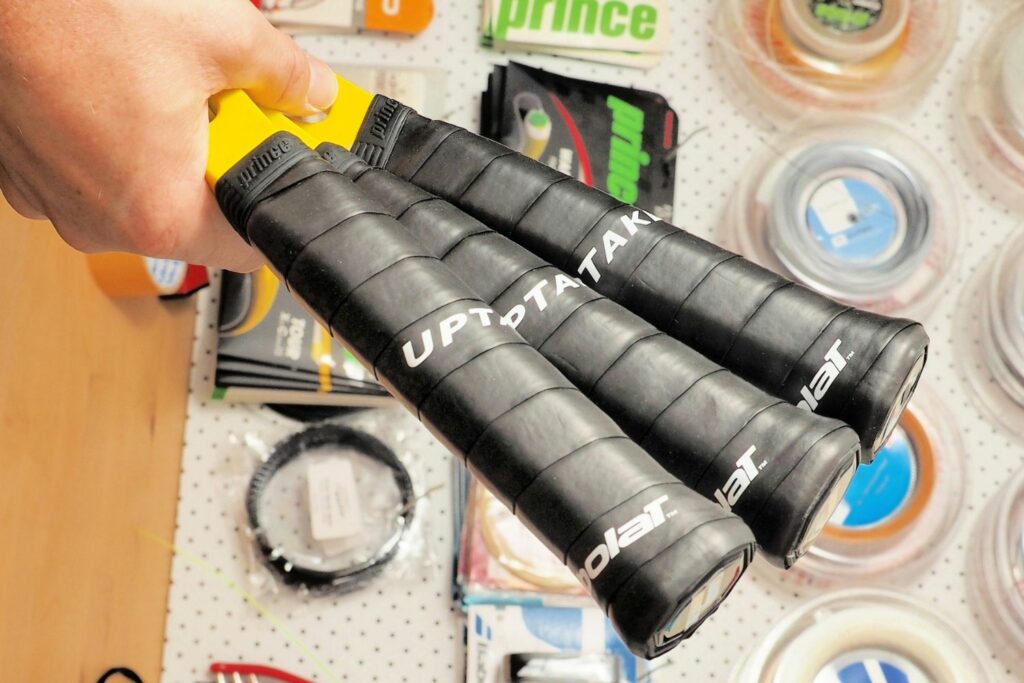
Step 7: Finish it off.
You can let the new grip as tight or loose as you like, based on your own preferences. When you finish the wrapping process, draw the line at the tape at the handle’s top. Peel back or use a pair of scissors to cut off the tape at the drawing line to cut the excessive parts.
Make sure to type it up by wrapping some finished tape at the grip to the point it overlaps itself and it’s secure. To be certain that the new grip won’t move from its place, you can slide down the vibrational dampener so that it will hold everything in place.
